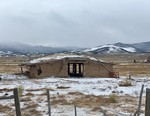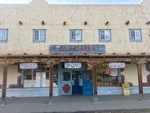The 2019 sites have been selected and officially announced!
Colorado Preservation Inc’s Most Endangered Places for 2019 are……
The resources Colorado Preservaiton, Inc. will be working on in 2019 were announced on Tuesday, February 5 during the Endangered Places Program Luncheon during the Saving Places® Conference at the Sheraton Downtown Denver Hotel. Since 1998, Colorado Preservation, Inc. has been working with communities throughout the state to save endangered historic buildings, landscapes, and archaeological sites through its Endangered Places Program. Five diverse places were listed and four important sites were recognized as SAVED. Learn more about the EPP program online here. Click on the photos and headings of the listed resources below to learn more about each location and view the short video on each place.
Adobe Potato Cellars of the San Luis Valley
 As many as 100 adobe potato cellars exist in the San Luis Valley that were constructed from the late 1880s through the mid-1960s for the storage of potatoes in naturally climate-controlled conditions. The cellars are both partially below ground structures with gambrel-shaped door entries and earthen roofs, to fully above ground, barn-like structures with wooden or later metal roofs. Many of the structures have beautifully built wooden front doors. Some feature a double-walled adobe construction, with an air pocket in between for better climate control. The adobe potato cellars dot the landscape of the valley and are in part a tangible reflection of the Hispano heritage of the area and the role potato production has played in the regional and statewide economy.
As many as 100 adobe potato cellars exist in the San Luis Valley that were constructed from the late 1880s through the mid-1960s for the storage of potatoes in naturally climate-controlled conditions. The cellars are both partially below ground structures with gambrel-shaped door entries and earthen roofs, to fully above ground, barn-like structures with wooden or later metal roofs. Many of the structures have beautifully built wooden front doors. Some feature a double-walled adobe construction, with an air pocket in between for better climate control. The adobe potato cellars dot the landscape of the valley and are in part a tangible reflection of the Hispano heritage of the area and the role potato production has played in the regional and statewide economy.
Hose Company No. 3-Fire House Museum

Built in 1895, Hose Co. No. 3-Fire House Museum in south Pueblo, witnessed the transition of firefighting and first responder technology, from hand and horse-drawn hose carts to motorized fire trucks, over the course of its nearly 80 years of operation. The fire station was the third unionized station under the auspices of the International Association of Firefighters (IAFF) in the United States, after Pittsburgh and New Orleans. The brick and stucco building housing the museum retains a high level of historic integrity but needs repairs to the exterior walls and foundation.
Iglesia de San Antonio-Tiffany Catholic Church
 Built with reverence and purposeful dedication, the lovely little Tiffany Catholic Church stands in testimony to the early Hispano settlement of southern La Plata County along the old Denver & Rio Grande Railroad line to Durango. The adobe and stucco church features a beautiful interior but its exterior is seriously deteriorated and needs attention and resources. The church is owned by the Diocese of Pueblo and hosts an annual mass in honor of Saint Anthony in June. Local caretaker families have kept the heritage of the church alive but seek help with preservation efforts to ensure its continued historic integrity and future viability.
Built with reverence and purposeful dedication, the lovely little Tiffany Catholic Church stands in testimony to the early Hispano settlement of southern La Plata County along the old Denver & Rio Grande Railroad line to Durango. The adobe and stucco church features a beautiful interior but its exterior is seriously deteriorated and needs attention and resources. The church is owned by the Diocese of Pueblo and hosts an annual mass in honor of Saint Anthony in June. Local caretaker families have kept the heritage of the church alive but seek help with preservation efforts to ensure its continued historic integrity and future viability.
 The McIntire Ranch is a historic archaeological site that includes the visible remains of the ranch headquarters established circa 1880 by Governor Albert McIntire and his wife Florence near the Conejos River and the abundant water supply of McIntire Spring. The Territorial Adobe ranch house exhibited a high degree of construction quality and materials and featured molded European sized adobe bricks, Italianate window openings, and a stucco finish. The ranch was listed on the National Register of Historic Places in 2008 for its association with social history, women’s history, and agriculture. It is imperative to save the ranch house ruins as quickly as possible to avoid further loss of historic integrity and to improve access to and interpretation of this highly significant property in Conejos County.
The McIntire Ranch is a historic archaeological site that includes the visible remains of the ranch headquarters established circa 1880 by Governor Albert McIntire and his wife Florence near the Conejos River and the abundant water supply of McIntire Spring. The Territorial Adobe ranch house exhibited a high degree of construction quality and materials and featured molded European sized adobe bricks, Italianate window openings, and a stucco finish. The ranch was listed on the National Register of Historic Places in 2008 for its association with social history, women’s history, and agriculture. It is imperative to save the ranch house ruins as quickly as possible to avoid further loss of historic integrity and to improve access to and interpretation of this highly significant property in Conejos County.
 R&R Market in San Luis is the oldest continuously operated business in Colorado in the state’s oldest town. The market was established as a trading post in 1857 by pioneer Dario Gallegos, who’s ancestors Felix and Claudia Romero have continued to operate it for nearly 50 years. The market is a social gathering center and source of fresh food and hardware that is the epitome of a “legacy business” that helps to define the character and identity of the community. The building also houses apartments upstairs with the market on the lower level. The building needs some repairs but the focus of saving it revolves around helping the owners successfully transition the business in their retirement to someone who can continue its community focus and orientation.
R&R Market in San Luis is the oldest continuously operated business in Colorado in the state’s oldest town. The market was established as a trading post in 1857 by pioneer Dario Gallegos, who’s ancestors Felix and Claudia Romero have continued to operate it for nearly 50 years. The market is a social gathering center and source of fresh food and hardware that is the epitome of a “legacy business” that helps to define the character and identity of the community. The building also houses apartments upstairs with the market on the lower level. The building needs some repairs but the focus of saving it revolves around helping the owners successfully transition the business in their retirement to someone who can continue its community focus and orientation.



